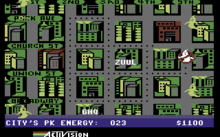Commodore 64 software
The Commodore 64 amassed a large software library of nearly 10,000 commercial titles, covering most genres from games to business applications, and many others.
Info 64, the first magazine produced with desktop publishing tools, was created on and dedicated to the Commodore platform.
The best known art package was perhaps KoalaPainter, primarily because of its own custom graphics tablet user interface - the KoalaPad.
A Commodore 64 version of The Print Shop existed, allowing users to generate signs and banners with a printer.
The Multiplan spreadsheet application from Microsoft was ported to the Commodore 64, where it competed against established packages such as Calc Result.
The typical C64 spreadsheet could store 64 columns and 255 rows, or 16,000 cells, but only 5-10% of them could be used at any one time, due to RAM limitations.
Due to its speed, ease of use, and full suite of office applications and utility software, GEOS provided a work environment similar to that of an early Apple Macintosh.
Arguably the best office applications appeared on GEOS because it was graphically advanced and not limited by the Commodore 64's screen area of 40-columns.
KoalaPad and light pen users could use GEOS too, which greatly increased the amount of clip art available for the platform.
This was due in part to the aggressive pricing of the Commodore 64 as a games machine and home computer (With rebates, the C64 was going for as little as US$100 at the time).
Its large installed user base encouraged commercial companies to flood the market with game software, even up until Commodore's demise in 1994.
Many books and magazines were published containing listings for games, and public-domain software was developed and released from both BBS systems and public domain libraries such as "Binary Zone" in the UK.
Of particular note, the smash hit Impossible Mission produced by Epyx was originally designed for the Commodore 64.
Cassette users may remember titles such as Master of Magic, Rocketball, One Man and His Droid, and Spellbound on Mastertronic's budget labels.
Other notable titles on the Commodore 64 include the Ultima and The Bard's Tale role-playing game series.
Hewson/Graftgold were responsible for several well-received C64 titles including Paradroid and Uridium—made famous for their metallic bas-relief styled graphic effects and addictive gameplay.
Notable game designers for the Commodore 64 are: Paul Norman, Danielle Barry, Andrew Braybrook, Stephen Landrum, Tim and Chris Stamper, Jeff Minter and Tony Gibson just to name a few.
As no game had ever received such a high rating before[citation needed], and as the commercial Commodore 64 scene was winding down in the mid-1990s, the awarding of 100% was seen as somewhat controversial.
The game, titled Mayhem in Monsterland, was developed to exploit a multitude of programming tricks and quirks in the Commodore 64's hardware to the maximum.
The impressive use of non-standard colors and scrolling resulted in perhaps the most graphically stunning game ever produced for the Commodore 64.
Numerous computer magazines offered type-in programs, usually written in BASIC or assembly language or a combination of the two.
[10] A large library of public domain and freeware programs, distributed by online services such as Q-Link and CompuServe, BBSs, and user groups also emerged.
Some of the most popular installations included the highly optimized and fast Blue Board program, and the Color64 BBS System, which allowed the use of color PETSCII graphics.
Also, sneakernets existed at schools and businesses all over the world, as friends and colleagues would trade (and usually later copy) their software collections.
Several popular utilities were sold that contained custom routines to defeat most copy-protection schemes in commercial software.
This overcame the difficulties in direct dubbing of later games using the high-speed loaders that were developed to overcome the very long load times.
The onboard BASIC programming language offered no easy way to tap the machine's advanced graphics and sound capabilities.
Aside from games and office applications such as word processors, spreadsheets, and database programs, the C64 was well equipped with development tools from Commodore as well as third-party vendors.
Using one of the frontends GameBase (Windows only) or jGameBase (platform independent) you can conveniently browse the database entries and directly start them in an emulator.
Special hardware has also been designed to aid the conservation of software, such as the IDE64 cartridge, which allows the user to connect a modern PC IDE ATA hard drive or a CompactFlash flashcard directly to the machine, giving the possibility to copy software onto the hard drive and use it from there, preventing wear on a decades-old floppy disk.




